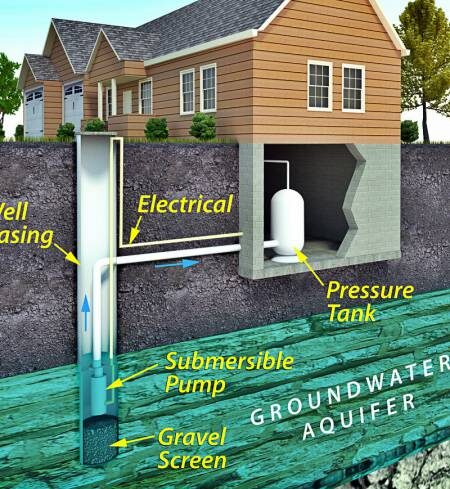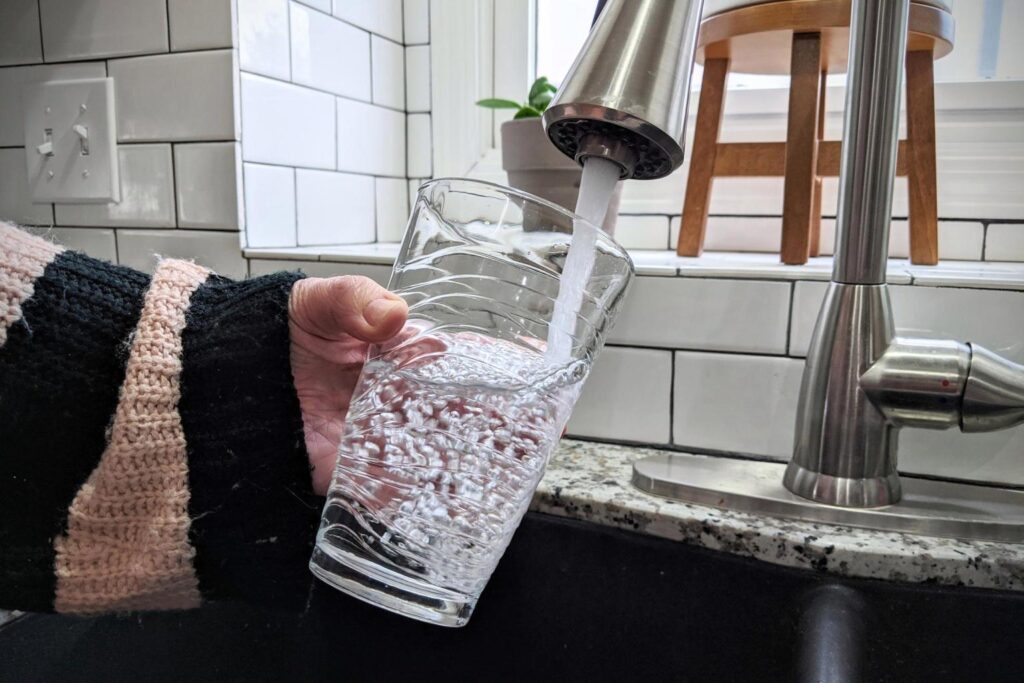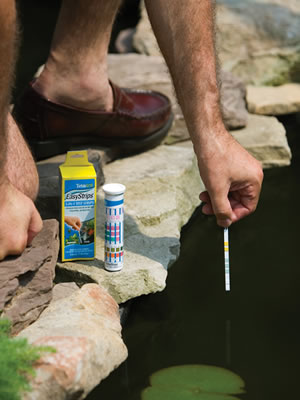Drinking Water Quality
as established a comprehensive and robust sampling and monitoring programme to ensure our water quality from source to tap. Water samples are collected from reservoirs, waterworks and distribution systems and tested at Water Quality Laboratory
The quality of our drinking water is regulated by the Environmental Public Health (EPH) (Water Suitable for Drinking) (No.2) Regulations 2019. The drinking water standards set out under the EPH Regulations were based on the WHO Guidelines for Drinking-water Quality.
makes continuous effort to maintain drinking water quality at the highest possible level.
Drinking water is normally clear but very occasionally may appear discoloured or contain particles. This may be caused by essential maintenance operations such as the routine cleaning of water tanks, flushing of service pipes in buildings and testing of fire hydrants. However, there are some instances where discoloured water can occur as a result of internal fittings and installations in our homes.
Why do customers sometimes encounter discoloured water?
Common causes of discoloured water occur due to maintenance operations such as routine cleaning of water tanks and the flushing of service pipes in buildings.

Water Safety
Families of students attending Department of Education (DOE) schools and staff of those schools should rest assured that our drinking water is of the highest quality in the world.
water meets or exceeds all Federal and State standards.
The City’s water is tested over 600,000 times each year.
The DOE works with other City agencies to make sure our students have safe drinking water in schools.
water is virtually lead-free when it is delivered from the City’s upstate reservoir system. However, the water can absorb lead from fixtures, faucets, and fittings. This is most likely to happen when water has not been run for several hours. You can minimize the potential for lead exposure by running your tap for 30 seconds, or until the water gets noticeably colder, before using the water for drinking or cooking.
Water Testing
State law requires us to test the water for lead every five years. In the 2016–2017 school year, the water in every public school was tested for lead
The findings were as follows:
The vast majority of test results were not elevated.
Ninety-two percent of our fixtures system-wide tested below guidance.
If a drinking or cooking outlet tested above guidance, the outlet was immediately turned off and the equipment was replaced.
The affected outlets are kept out of service until follow-up testing shows those outlets no longer have elevations.
Every elevated fixture from this round of testing has been remediated.
Standard Response Protocol
If a building has even one water outlet that tests above the action level (which means it contains greater than 15 parts per billion (ppb) of lead), the DOE implements its standard response protocol.

Buying a Home With a Well: What You Need to Know
Things To Consider When Buying A Home With A Well’
Buyers considering homes in rural settings will often encounter homes for sale that get their water from wells. With homes drawing on municipal sources, there is an assumption that the water in the home will be readily available and meet the safety standards of the municipality
But with well water, you cannot make any assumptions about its purity. Beyond water quality, other problems can arise with wells that you should be aware of, and check for, before you agree to purchase a home.
Whether buying or selling a home, there are always questions that come up regarding testing the water when a property is serviced by a private well. If you are purchasing a home that is serviced by a well and not by public water you better make darn sure that you have it tested as part of your contingency of sale!
When you are testing the water, you are going to want to do what is known as quality and quantity test. Both of these tests are equally important as you want to make sure the water is safe but also that you will have enough to service the home properly.
Do your research about water in the area.
Groundwater is a shared resource across broad areas, so problems that affect one home will often affect many, many more. You can research known water issues in an area through the EPA, and you can ask your Realtor of any known water problems in the area. Once you know of common problems, you can be on the lookout for them

What You Don’t Know About Well Water Could Hurt You
How clean, and safe, is that water? Short answer: It depends. But new research suggests those wells deliver water tainted with a range of pollutants. Some leaked from dry cleaning operations. Yet far more wells soak up, and deliver to taps, fertilizer that’s been building up in soil and water over generations of modern farming.
But it’s not up to regulators from agencies in Topeka to test private well water quality. That falls to individual well owners. With little to no government oversight, some public health officials worry that’s creating a system where far too many people are left vulnerable to potential cancer-causing pollutants and toxins.
The main culprit is a dramatic increase in the amount of nitrate. It’s a byproduct of the Green Revolution of the 1960s that turbo-charged modern farming toward greater yields, especially the use of chemical fertilizers.
Farmers learned that soil laced with extra nitrogen could squeeze more bushels from an acre of land. But not all that nitrogen stays put or gets absorbed in wheat, corn, sorghum and soybeans. Some runs off into streams, or trickles into underground reservoirs.
High levels of nitrogen in water can lead to shortness of breath. It can even cause death in young children and older adults. The federal Safe Drinking Water Act, which only governs public drinking water, limits nitrate levels to less than 10 milligrams per liter.
HOW TO PROPERLY USE A POND WATER TEST KIT
Those of us in the business understand that in spite of our best efforts a customer’s pond paradise may turn into a nightmare if they do not perform some basic maintenance tasks. To make sure our customers’ ponds remain a welcome retreat from an otherwise stressful world we educate them about proper feeding amounts, how to flush the filter or rinse the pads, how to keep away predators, proper circulation, and basic plant and fish care tips.
With all the great things we do for our customers there is one piece of valuable ammo we often fail to arm them with. A simple water test kit is not only an added sale and a precursor to additional treatment purchases but it can be the first line of defense in a customer’s battle for water quality and a healthy pond.
With so very many choices in test kits, parameters tested, and testing procedures available it is no wonder that some pond retailers and installers are reluctant to make a recommendation to their customers.
Fortunately, most water quality experts agree on a handful of tests that every industry professional and pond owner should perform.
AMMONIA – Ammonia is formed when fish waste and other organic debris (leaves, grass, dead fish, or frogs, etc) begin to decompose. This decomposition releases toxic Ammonia into the pond water. A test reading of Zero Ammonia is best but not always possible.
NITRITE – Nitrifying bacteria work on the Ammonia and break it down to Nitrite. Nitrite is also highly toxic to your pond fish and the ideal reading should again be Zero.
NITRATE – Eventually Nitrite is broken down further into Nitrate, which is less toxic to your pond fish although still bad enough in higher concentrations. Ideal reading would be zero. NOTE: Many industry experts suggest testing for both Nitrite and Nitrate in your pond but others believe testing for Nitrite is sufficient.
pH – Testing the pH of your pond is critical according to many experts. The ideal pH reading in your pond is debatable by many but is often considered to be 7.0 – 7.5 although pH will vary throughout the day.
KH – Carbonate Hardness = Total Alkalinity which is different than pH. Carbonate Hardness is the ability of the pond water to stabilize the pH in the system. According to Dave Jones, owner of The Pond Professional in Woodstock GA, KH should be at least 100 PPM. Ideal KH readings are between 100-200 PPM.
PHOSPHATES – Phosphates are usually introduced into a pond thru fish waste and are a nutrient that algae require to flourish. Algae, like other plants, require many nutrients to grow so the presence of Phosphates alone does not ensure an algae problem is imminent. A reading of Zero PPM is ideal although many ponds can have much higher concentrations with no algae issues present.